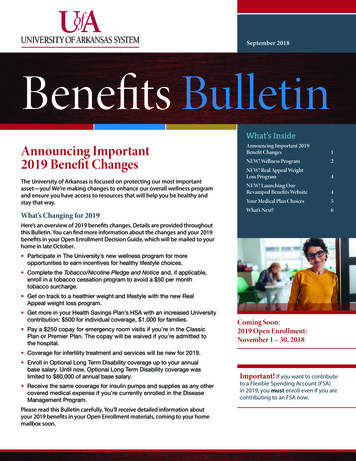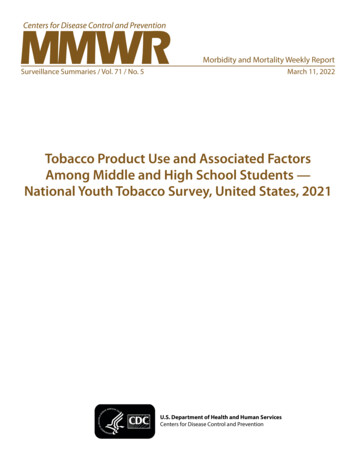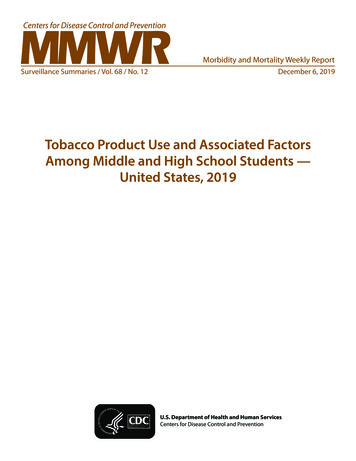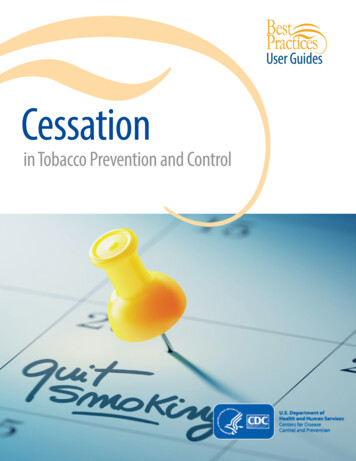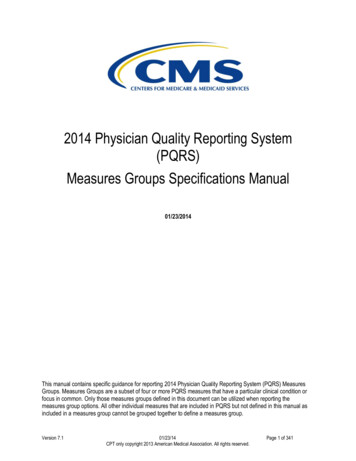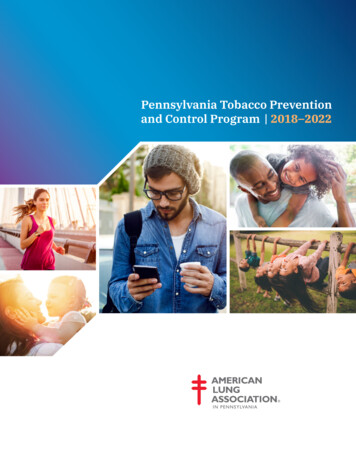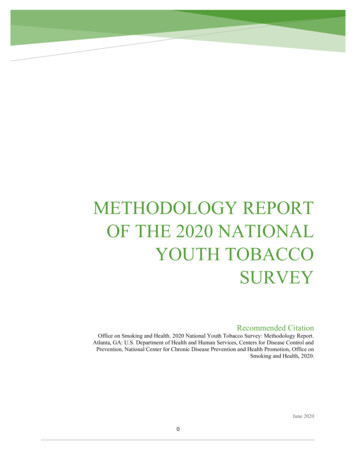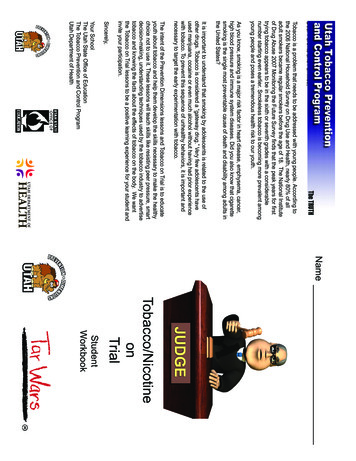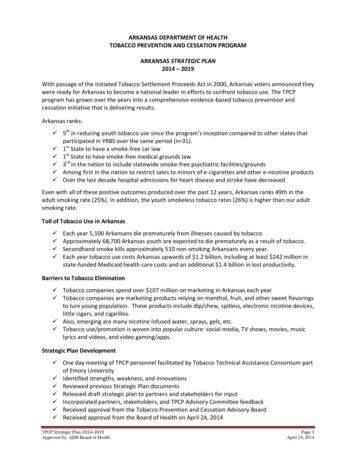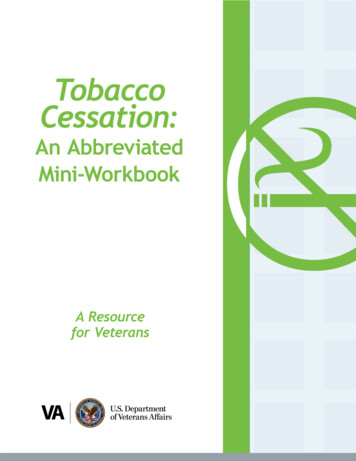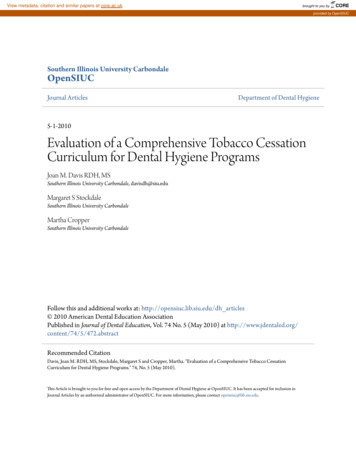
Transcription
View metadata, citation and similar papers at core.ac.ukbrought to you byCOREprovided by OpenSIUCSouthern Illinois University CarbondaleOpenSIUCJournal ArticlesDepartment of Dental Hygiene5-1-2010Evaluation of a Comprehensive Tobacco CessationCurriculum for Dental Hygiene ProgramsJoan M. Davis RDH, MSSouthern Illinois University Carbondale, davisdh@siu.eduMargaret S StockdaleSouthern Illinois University CarbondaleMartha CropperSouthern Illinois University CarbondaleFollow this and additional works at: http://opensiuc.lib.siu.edu/dh articles 2010 American Dental Education AssociationPublished in Journal of Dental Education, Vol. 74 No. 5 (May 2010) at Recommended CitationDavis, Joan M. RDH, MS, Stockdale, Margaret S and Cropper, Martha. "Evaluation of a Comprehensive Tobacco CessationCurriculum for Dental Hygiene Programs." 74, No. 5 (May 2010).This Article is brought to you for free and open access by the Department of Dental Hygiene at OpenSIUC. It has been accepted for inclusion inJournal Articles by an authorized administrator of OpenSIUC. For more information, please contact opensiuc@lib.siu.edu.
Evaluation of a Comprehensive TobaccoCessation Curriculum for Dental HygieneProgramsJoan M. Davis, R.D.H., M.S.; Margaret S. Stockdale, Ph.D.; Martha Cropper, M.S.Abstract: Dental health care providers continue to offer inconsistent and limited tobacco use cessation (TUC) interventionseven though smoking-related morbidity and mortality continue to be a substantial health concern. Our purpose was to conduct acomprehensive, three-year (2003–06) TUC curriculum evaluation that included assessment of existing TUC education offered;dental hygiene educators’ readiness to incorporate TUC education into the curriculum; and development of a pre-test/post-testassessment instrument and faculty development program. This curriculum study was carried out alongside a research study toevaluate the effectiveness of a peer-reviewed tobacco curriculum (Tobacco Free! Curriculum). Faculty members (baseline n 97;third-year n 42) from the twelve dental hygiene associate degree programs in Illinois participated in the study, which includeda pre-treatment survey, six hours of on-site TUC curriculum training, and a post-treatment survey to determine the attitudes,perceived barriers, and current practices in tobacco education. Results showed an average increase of eighty-five minutes spent ontobacco education in the dental hygiene curriculum, a large positive increase in the percentage of faculty members who formallyassessed the use of 5As and 5Rs (21 percent to 88 percent), and a dramatic increase ( 100) in the percentage of faculty memberswho taught or included most of the thirteen TUC content areas following the introduction of the curriculum and training program.Prof. Davis is Associate Professor of Dental Hygiene; Dr. Stockdale is Professor of Psychology; and Ms. Cropper is FormerField Representative, Center for Rural Health and Development—all at Southern Illinois University. Direct correspondence andrequests for reprints to Prof. Joan M. Davis, Dental Hygiene, Southern Illinois University, 1365 Douglas Drive, Carbondale, IL62901-6615; 618-453-8874 phone; 618-453-7270 fax; davisdh@siu.edu.Keywords: tobacco cessation education, dental hygiene curriculum, cancer education, dental education, clinical competenceSubmitted for publication 11/29/09; accepted 1/6/10In the United States, it is estimated that 43.4million (19.8 percent) adults currently smoke.1Although smoking has continued to decline, itis unlikely that the Healthy People 2010 objectiveof 12 percent will be reached.2 For more than fortyyears, the medical and dental health care communitieshave had access to research confirming that smokingis a risk factor or strong risk factor for numerousforms of cancer, heart disease, and stroke.3,4 Theevidence has steadily grown linking tobacco use asa major or significant risk factor to the developmentof oral cancer, periodontal diseases, tooth loss, dentalcaries in children exposed to secondhand smoke,and implant failure,5-9 and it remains the number onecause of preventable death in the United States.10In response to the urgent need to reduce tobaccouse, the U.S. Public Health Service (PHS) releasedits tobacco use and dependence guideline in 2000,11offering health care providers an evidence-basedguideline for treating patients who use tobacco. Thisguideline is considered the gold standard for tobaccocessation treatment by establishing recommendationson how to effectively prescribe cessation medications.The guideline also stresses the value of utilizing allof the 5As (Ask, Advise, Assess, Assist, Arrange), if472possible, to achieve the greatest effect. A strong caseusing an extensive meta-analysis was made statingthat the greater the intervention provided, the morelikely the patient will succeed in his or her quit attempt. In 2008, a new updated version of the PHSguideline was released including instructions on howto use the newly released pharmaceutical varenicline,as well as a section on motivational interviewingtechniques.12 Unfortunately, there continues to be atendency for health care providers to Ask and Advisebut rarely go into Assessing their cessation needs;Assisting by discussing medications, a quit plan,or a quitline; or Arranging any follow-up. Hu et al.found that 89 percent of the dentists they surveyedwere unaware of the PHS guideline and less than 20percent spent three or more minutes on tobacco cessation per patient.13 In a national study of oral andmaxillofacial surgeons, 21.9 percent of respondentsreported that they assisted tobacco-using patientsmost of the time, but only 14.5 percent were awareof the PHS guideline.14 In both studies, the lack oftraining was cited by clinicians as a primary barrierto providing tobacco use cessation (TUC) services.In response to the overwhelming scientificevidence of tobacco-related oral disease and theJournal of Dental Education Volume 74, Number 5
availability of effective cessation strategies, dentaland dental hygiene educators have been activelymoving towards the inclusion of tobacco cessationinformation in their curricula. In a recent study, dentalhygiene students reported an increased confidencein providing TUC following training.15 In similararticles, the dental schools at Indiana University16and the University of Louisville17 reported innovativetobacco cessation programs utilizing mentoring byexpert faculty members and standardized patientsrespectively.This article reports descriptive data generated from a three-year (2003–06, plus a one-yearextension), multifaceted tobacco education curriculum initiative that was implemented in the twelveassociate-level dental hygiene programs in Illinois.The instrument development and baseline data fromthis project were published in the Journal of DentalEducation18 in 2005 and the Journal of CancerEducation19 in 2006. The purpose of this article is toreport the changes in tobacco cessation curriculumpedagogical practices from the beginning of theproject (baseline) to the end (final post-test).Project BackgroundIn August 2003, we were awarded a three-yearAmerican Cancer Society-Illinois Division (ACS)grant titled “Assessing Effectiveness of Standard ofCare Curriculum for Tobacco Education in a DentalHygiene Context.” The aim of this three-year study(Figure 1) was to explore the state of tobacco education in the twelve programs; it included multifacetedformative and summative evaluations of a newlydeveloped tobacco education curriculum, TobaccoFree! Curriculum. The components of the ACS project included a focus group for survey development,baseline (pre-test) and two follow-up (post-test)surveys, an initial six-hour on-site curriculum facultydevelopment training program, the complete TobaccoFree! Curriculum on CD and in binder format, dentalhygiene student post-graduation surveys, and ongoing resource updates. The six-hour faculty development training program included active participation,a question-and-answer period, and role-play in orderto increase participants’ sense of being prepared tomodel and evaluate a behaviorally based TUC in aclinical setting. Determine the needs and readiness of dental hygiene (DH) educators forincorporating tobacco prevention and cessation education and counselinginto postsecondary curricula. Develop an assessment instrument, based on the theory of planned behavior,awhich predicts that intention to engage in behavior change is a function ofattitudes, social norms, and perceived ability to control both the internal (i.e.,self-confidence) and external barriers to change. Conduct a randomized controlled experiment to evaluate the effectiveness ofa professionally developed tobacco curriculum (Tobacco Free! Curriculum)and accompanying technical support designed for DH educators in increasingthe adoption of the curriculum and time spent training DH students ontobacco education. Examine the diffusion of the intervention among DH graduates who participated in either the intervention or control programs to determine theirintention and actual implementation of tobacco prevention and cessationeducation and counseling in their new practices.aSee Ajzen I. The theory of planned behavior. Organ Behav Hum Decis Process1991;50:179–211.Figure 1. Aims of the ACS three-year tobacco cessation curriculum studyMay 2010 Journal of Dental Education473
The Tobacco Free! Curriculum, originallynamed Leading the Way, was developed by one of theauthors (JMD) in fulfillment of a nationally competitive Tobacco-Cessation Curriculum-DevelopmentFellowship awarded by the American Dental Hygienists’ Association (ADHA) Institute for Oral Healthand GlaxoSmithKline, Inc. in 2002. The curriculumwas developed in accordance with the AmericanDental Education Association (ADEA)’s dentalhygiene competencies.20 The ADEA dental hygieneAPIE model (Assess, Plan, Implement, and Evaluate)was combined with the U.S. Public Health Serviceguideline 2000’s 5As (Ask, Advise, Assess, Assist,Arrange) and the 5Rs (Relevance, Risks, Rewards,Roadblocks, Repetition) for those patients who areunwilling to quit. (Note that the most recent versionof this guideline is the 2008 update.12) The aim ofthe curriculum was to provide dental hygiene faculty members with evidence-based, comprehensiveteaching resources in order to prepare their studentswith the knowledge and skill sets to confidently andeffectively offer tobacco-cessation interventions inschool and clinical practice.The curriculum contains six learning modules:1. Historical overview and the importance of themedia, chemical hazard of both smoked andsmokeless tobacco, the addiction process, andbehavioral aspects of nicotine addiction.2. General and oral-related diseases such as oralcancer, periodontal disease, and lung cancer.3. Behaviorally based tobacco prevention andcessation interventions, which included the5As, 5Rs, brief motivational interviewing, stagesof change, and active listening.4. Cessation medications including the proper useof nicotine replacement therapy, varenicline, andbupropion.5. How to establish a clinical TUC program inpublic or private practice, which included the useof the Internet, state quitlines, and referral to atobacco treatment specialist.6. Community action activities such as preventionactivities at health fairs and schools and publichealth initiatives.The content from these six learning modulesinformed the thirteen identified content areas usedfor the baseline and Year 3 participant surveys.Following the TUC faculty training, the program director and faculty members were allowed todecide when and how they were going to utilize theTUC curriculum. The modules were designed to beflexible and could be incorporated into courses such474as periodontics, oral pathology, or clinic seminarover a two- or three-year period or sequentially ina six-part series. If course time did not allow, thecurriculum could be offered as an independentlearning module for self-instruction. Each modulecontained an overview, learning objectives, contentoutline, learning activities, assessment tools, references, presentation slides, and talking notes. Thecurriculum also included an instructor’s manual(Faculty Guide), educational slides, and extensiveeducational resources. A toolbox was included tocentralize all outlines, knowledge tests, competencyrubrics, handouts, and reference materials.An essential component of this curriculumwas the establishment of a behaviorally based TUCprogram leading to clinical competence. Tobaccocessation interventions are multifaceted and are intended to bring about complex behavioral changes.As with any complex skill, students must be giventhe opportunity to synthesize and apply the information they have learned in the classroom. Withoutthe opportunity to practice TUC intervention skills,clinicians often lack the confidence to provide thisimportant service and may not carry it into clinicalpractice. The complete curriculum has been madeavailable nationally and internationally via theInternet and can be downloaded at www.sah.siuc.edu/tobacco.MethodsThe original study design was a pre-test/posttest control group design with a second post-testconducted at the completion of the study. The studypopulation consisted of faculty members (baselinen 97; third-year n 42) at the twelve communitycollege-based dental hygiene programs in Illinois.Although we attempted to randomly assign programsto an experimental group, which would be trained onthe curriculum in Year 2 of the study, and a wait-listcontrol group, which would continue their existingcurriculum in Year 2 and be trained on the curriculumin Year 3, we encountered several obstacles in maintaining this design. First, a small number of programstold us whether they could serve in the experimentalor control group based on institutional constraintsthey were facing at the time, such as preparing foraccreditation. Second, one program dropped out ofthe study after the baseline survey was completedbecause of loss of program faculty. Third, to accom-Journal of Dental Education Volume 74, Number 5
modate scheduling issues, we were training some ofthe experimental group programs in the third year,while training the control group in the same timeframe. As a result, treatment differences were diffused across experimental conditions. Therefore,we are reporting only the overall changes in tobaccocessation pedagogy for both groups combined fromYear 1 (baseline) to Year 3 (final post-test) after allprograms were trained on the curriculum.Participants and MeasuresFor the Year 1 baseline survey, ninety-seven faculty members from the twelve programs completedthe survey. Of these, 55 percent were part-time (42percent full-time; 3 percent did not answer), 88.7percent were women, and 14.4 percent were programdirectors. The majority of participants taught bothclinic and lecture courses (52.6 percent), whereas44.3 percent taught only clinic courses and 2.1 percent taught only lecture courses. A B.A. or B.S. wasthe modal degree for 42.3 percent, followed by anM.A./M.S. degree (24.7 percent).For the Year 3 follow-up survey, forty-two faculty members from eleven programs completed thesurvey (58 percent from the experimental programsand 42 percent from the control programs). Of these,54 percent were part-time, 86 percent were women,and 17.1 percent were program directors. The modaldegree was an M.A./M.S. for 34.1 percent, followedclosely by a B.A./B.S. degree (31.7 percent). Themajority of participants taught both clinic and lecturecourses (52.5 percent), whereas 37.2 percent taughtonly clinic courses and 7 percent taught only lecturecourses.Among other questions, both the baselinesurvey and the Year 3 follow-up survey assessed theextent to which respondents covered various topics related to tobacco education in their curricula.Separate items addressed didactic and clinic classes.For the didactic questions, respondents indicatedwhether they covered each of thirteen tobacco education topics in their courses and, if so, how muchtime (in minutes) they spent on each topic. For theclinic questions, respondents indicated whether eachof seven tobacco-related intervention skills was assessed formally, with a form, and how frequentlythe competency was assessed. Responses to thelatter question were measured on a five-point scaleranging from 1 (never) to 5 (always). A variety ofdemographic questions were asked as well.May 2010 Journal of Dental EducationResearch ProcedureAs reported in an earlier publication,18 facultymembers completed the baseline survey during meetings at their institutions, and these were collected bya member of the research team. Surveys and postagepaid return envelopes were given to faculty memberswho did not attend the meetings.The follow-up surveys were distributed by mailto the program directors. For programs with sluggishreturns, a member of the research team visited theprogram and obtained completed surveys. All participants received a 25.00 gift certificate for completingthe follow-up survey.ResultsQuestions pertaining to coverage of tobaccotopics in didactic courses and those pertaining to assessment of tobacco cessation competencies in cliniccourses were analyzed separately. The results for theformer are based on faculty members who taughtlecture (didactic) courses (baseline study, n 53; Year3 follow-up study, n 24), whereas results for the latterare based on responses from faculty members whotaught clinic courses (baseline study, n 94; Year 3follow-up study, n 37). (The results for the baselinedata presented here do not match those reported bythe authors in a previous publication,18 because thecurrent analyses were based on a more precise subsetof participants so that comparisons with the follow-upsurvey results would be more meaningful.)Tobacco Topics Covered inDidactic CoursesThe tobacco-related material in all of the thirteen identified content areas was covered by at leastone faculty member (in one program) at both thebaseline and the three-year follow-up: historical/social, tobacco-related general diseases, tobacco-relatedoral diseases, nicotine dependence, tobacco cessationstrategies, 5As and 5Rs, stages of change, brief motivational interviewing (BMI), FDA-approved smokingcessation pharmacotherapies, comprehensive tobaccointervention, community-based tobacco control, andpersonal tobacco use by students. Moreover, dramaticincreases in the percentage of faculty members whotaught each of these topics were observed from thebaseline to the three-year follow-up. The percentage475
of didactic faculty members who taught each of thesetopics can be found in Table 1.Almost all content areas saw more than a 100percent increase following the intervention. Onlythose topics that were traditionally presented in thedental hygiene curriculum (general pathology andtobacco-related pathology) had less than a 100 percent increase. These figures show a strong increase incontent areas included in the curriculum as comparedto pretraining in the Tobacco Free! Curriculum twoyears before.The average number of minutes spent on eachtopic area by respondents who identified themselvesas lecture faculty is also presented in Table 1. Pretraining baseline averages show the highest numberof minutes spent on the historical and social significance of tobacco (forty-one minutes), comprehensivetobacco intervention strategies (thirty-eight minutes),and tobacco-related oral diseases (thirty-four minutes) content areas. In the final survey (year 3), timespent on the historical and social significance oftobacco and on comprehensive tobacco interventionsdecreased, but gains were observed on all of the othertopics, most notably the 5As and 5Rs (forty-fourminutes), tobacco cessation strategies (forty-sevenminutes), and stages of change (thirty-six minutes).On average, participants reported spending overeighty-five more minutes on tobacco control topics at the three-year follow-up than was reported atbaseline.Tobacco Cessation CompetenciesAssessed in Clinical CoursesFaculty members who taught clinic coursesreported that all seven tobacco cessation competencies were assessed formally by some faculty members(see Table 2). The highest percentage of clinic facultymembers assessed whether the patient uses tobaccoand associating head and neck exam assessment totobacco use at baseline (52 percent and 48 percent,respectively), but gains were seen in the percentage offaculty members who assessed these competencies atthe three-year follow-up (78 percent and 68 percent,respectively). There was a large, positive change inthe percentage of clinic faculty members who assessed providing cessation resources and follow-up(408 percent change); using brief motivational counseling (345 percent change); following the 5As and5Rs (256 percent change); and discussing tobaccocessation/prevention strategies with clients (230percent change). There was very little change in therated frequency with which each of the competencieswas formally assessed.Table 1. Changes in coverage of tobacco control topics in dental hygiene didactic courses from baseline to Year 3follow-upPercentage of Lecture FacultyWho Teach TopicHistorical/social significance of tobaccoTobacco-related general diseasesTobacco-related oral diseasesNicotine dependenceTobacco cessation strategiesTobacco prevention strategies5As and 5RsStages of changeBrief motivational interviewingCessation pharmacotherapiesComprehensive tobacco interventionCommunity-based tobacco controlPersonal tobacco useBaseline(n 53)Year 3(n .36615.52136.83Average Time Spent on Topic(minutes)SumBaselineYear 3-10.362.148.2785.59Note: Ns for the faculty members at baseline reporting the amount of time they spent on the topic ranged from six to twenty-seven,whereas for the follow-up survey, Ns ranged from seven to fourteen.476Journal of Dental Education Volume 74, Number 5
Table 2. Changes in assessment of tobacco cessation competencies in clinic from baseline to Year 3 follow-upPercentage of Clinic FacultyWho Assess Competency FormallyAssessing whether the patient uses tobaccoAssociating head and neck exam findingsto tobacco use, if relevantAssessing stages of change amongtobacco-using clientsDiscussing tobacco cessation/preventionstrategies with clientsFollowing the 5As and 5Rs for conductingtobacco cessation counselingUsing brief motivational counselingProviding cessation resources and follow-upFrequency of AssessmentBaseline(n 94)Year 3(n 0.05BaselineYear 3DifferenceNote: Ns for the faculty members reporting the amount of time spent on the topic at baseline ranged from eighteen to fifty-nine,whereas for the follow-up survey, Ns ranged from twenty-four to thirty-one.DiscussionAssessments of the state of tobacco educationin U.S. dental/dental hygiene curricula have primarilyconsisted of students’ perceptions and receptivity totobacco cessation curricula15,21,22 and national surveys of tobacco education in dental/dental hygieneschools.23-25 Our unique prospective study followedboth clinical and didactic dental hygiene facultymembers over a three-year period determining thetime spent, content offered, and competencies assessed before and after faculty training in a comprehensive tobacco education program, the TobaccoFree! Curriculum.To the credit of the participating educators, theresults of the baseline survey indicated that many ofthem were already presenting tobacco-related healtheffects and various levels of cessation interventionsin their didactic and clinical courses. Of particularimportance is the substantial increase of formal(i.e., with a form) assessment of specific elementsin a comprehensive tobacco intervention (Table 2).While faculty members reported including TUC inthe classroom, only limited assessment in the clinicalsetting was being conducted prior to the curriculumintervention. While dental hygiene educators haveautonomy to decide what is formally assessed inthe clinical setting, priority may be given to theknowledge and skills that are deemed essential toclinical practice. Since the importance and valueof TUC are widely accepted in the field of dentalMay 2010 Journal of Dental Educationhygiene, it may be reasonable to advocate the inclusion of tobacco cessation as a component of requiredclinical evaluations to ensure that students will becompetent in this essential skill. In the areas in whichfoundational tobacco content such as the effects oftobacco on oral tissues and periodontitis were strongin the baseline survey, they remained strong in thethird year. However, new topics such as the PHSguideline 5As and 5Rs greatly increased in both thepercentage of faculty members (21 percent to 88percent) and minutes spent (twenty-four to forty-fourminutes) by Year 3.This study did not separate the potential effectof the six-hour onsite faculty training on curriculumimplementation from the Tobacco Free! Curriculummaterials if provided alone. During the training, faculty members did express a high degree of interest ina more comprehensive TUC program that includedcessation medications, formal clinical competencies,and effective tobacco prevention community outreachtools. It is possible that there existed a synergisticeffect of knowledge acquisition, role-playing, and opportunity to strategize implementation that may haveenhanced the overall adoption of the TUC program.The training format may have allowed the entirefaculty of these programs to learn, digest, practice,discuss, and plan how to implement this new information as a unit. In addition, a TUC coordinator wasdesignated by the program director at the conclusionof the training as a contact person for future updatesand to encourage follow-up.477
Participants in our focus group indicated thatthe lack of time in an already full curriculum wasthe primary reason for not including comprehensiveTUC. This finding was consistent with research examining other content areas such as family violence26and ergonomic education27 as well as TUC studies24,25in which faculty members reported a lack of trainingand lack of time to develop new material as primarybarriers to adoption of new information. Removingthe barriers of lack of time or expertise by providingfaculty development and ready-made educationalunits may move more complicated, behaviorallybased interventions such as tobacco cessation intofundamental curriculum instruction faster than thatwhich we have experienced in the past.These results suggest that the flexible components of the Tobacco Free! Curriculum combinedwith faculty training may have motivated both clinical and didactic faculty members to become moreinvolved with tobacco education resulting in moreminutes spent overall and more faculty membersinvolved in formal competencies. This positive effecthas also been reported in studies focusing on facultymembers’ tobacco education training for nurses28 andnurse practitioners.29The primary strength of this study lies in thevery committed dental hygiene faculty members whowere willing to take the time to participate in thislong-term study and make an earnest effort to integrate a comprehensive tobacco cessation curriculuminto an already full program. Their level of interestand enthusiasm speaks highly of their commitment tomove this extremely important topic from an “extratopic if there is time” to an essential component intheir curricula.The primary weakness of this study lies inthe inability to train and then evaluate the controland experimental schools as discrete groups. Eachprogram offered its TUC unit(s) in unique and varied time frames during its professional sequence.Therefore, the six schools in the treatment groupmay not have been able to integrate the material untilsometime the following year, whereas the controlprograms may have started teaching the material thenext week. In addition, participant mortality due tofaculty turnover and personal issues could not becontrolled for and resulted in a reduced participantnumber in Year 3.478Future Research DirectionsFuture research directions may include the reproduction of this study in dental hygiene programsnationwide to explore the level of current tobaccoeducation and potential expansion of a comprehensive TUC curriculum based on the PHS 5As and 5Rs.Another direction may be to examine the process ofhow a new or extra subject such as tobacco cessation is integrated or diffused through a health carecurriculum. This may provide a guideline or bestpractice template for educators to follow. Identifyingbest practices for the diffusion of new curricularinnovations may assist in not only the establishmentof comprehensive tobacco cessation education but inmoving forward other important health care issuessuch as diabetes, obesity, and family abuse interventions into the dental setting.REFERENCES1. Centers for Disease Control and Prevention. Statespecific prevalence and trends on adult cigarette smoking—United States, 1998–2007. Mor Mortal Wkly Rep2009;58(9):221–6.2. U.S. Department of Health and Human Services. Healthypeople 2010: understanding and improving health, 2nd ed.At: www.healthypeople.gov/. Accessed: October 2009.3. American Cancer Society. Cancer facts and figures. Atlanta: American Cancer Society, 2009.4. U.S. Department of Health and Human Services. Thehealth
requests for reprints to Prof. Joan M. Davis, Dental Hygiene, Southern Illinois University, 1365 Douglas Drive, Carbondale, IL 62901-6615; 618-453-8874 phone; 618-453-7270 fax; davisdh@siu.edu. . as periodontics, oral pathology, or clinic seminar over a two- or three-year period or sequentially in a six-part series. If course time did not .
